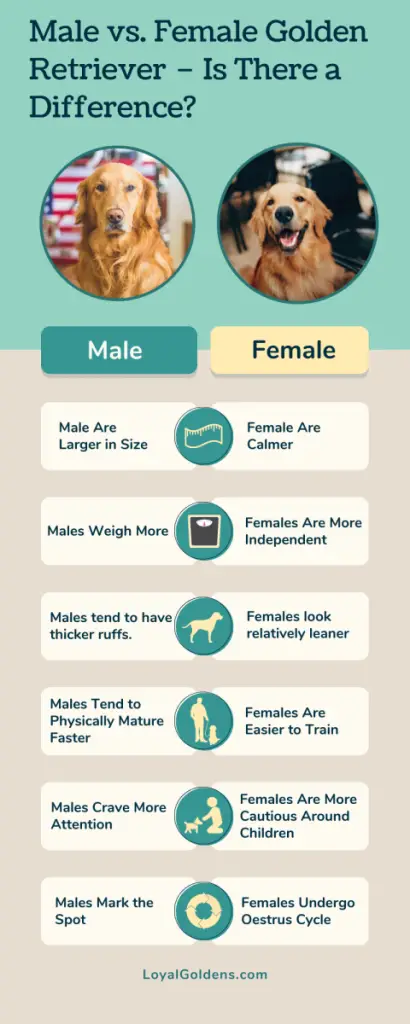Golden retrievers, both male and female, are wonderful dogs. But when it comes to owning a golden retriever, there is always the question of whether one is more aggressive, more dominant, or more territorial than the other. Though largely similar, there are subtle differences between male and female golden retrievers that you’ll notice on close observation.
Male golden retrievers are typically larger and heavier than females. Male goldens also run faster and tend to crave more attention from their humans. Female golden retrievers are smaller, calmer and in terms of temperament, are slightly easier to train.
Even though they tend to look quite similar—physically and behaviourally, there are many areas where male and female golden retrievers are distinct and different. Keep on reading to see how the two retrievers differ.

(This article may contain affiliate links and loyalgoldens may earn a commission if a purchase is made.)
Unlock your goldens natural intelligence and see just how quickly problem behaviors disappear.This is the best at home dog training I've ever used!
Key Traits That Make Male Golden Retrievers Different From Their Female Counterparts
Certain characteristics help differentiate between male golden retrievers and female goldens. Though, as you may see, most of these attributes are physical. Perhaps the most glaring difference between a male and a female golden retriever is their size, but the contrasts are not just limited to size, they tend to have other nuanced distinctions.
Male Golden Retrievers Are Larger in Size
Apart from the apparent difference in their genitalia, male golden retrievers are physically bigger than females. The males are taller than the females by about two to four inches.
Largely, golden retrievers are considered a medium-sized dog when compared to other breeds. The retriever males tend to be larger in size than their female counterparts. And perhaps this is the most obvious difference between a male and a female golden retriever.
While male golden retrievers can reach an average maximum height of 23 – 24 inches (58.42 – 60.96 cm), female retrievers are usually between 21.5 – 22.5 inches (54.61 – 57.15 cm).
Male Golden Retrievers Weigh More Than the Females
Structurally, male golden retrievers are more imposing. The difference in size is not just limited to their height but also their body weight.
With male golden retrievers weighing anywhere between 65 and 75 lbs (29.48 – 34.01 kilos), they are heavier than the female retrievers whose average weight is between 55 and 65 lbs (24.9 – 29.48 kilos).
Other Physical Differences Between Male and Female Golden Retrievers
There are a few other physical traits that help distinguish between the male and female golden retrievers. The males tend to have thicker ruffs, slightly longer coats, a greater mane, and broader heads than their female counterparts. Female golden retrievers look relatively leaner with their narrower noses and heads and slightly shorter fur.
It could be said that in regard to physical appearances, the female retrievers have less of everything than the male has. They are two to four inches shorter and ten to twenty pounds lighter than their male counterparts.
Females are also more elegant looking as their heads are narrower and not as broad as that of the males. Their fur coats are also thinner, and they are less bulky and have less muscle mass.

Males Tend to Physically Mature Faster Than Females
When it comes to bladder control, male retrievers physically mature faster than females. They also grow in size and attain their full adult body weight quicker than female golden retrievers. With potty training and crate training, males can hold their bladders for longer and are quicker to potty train, spot train, and crate train as a result.
Females retrievers, undoubtedly, do better in obedience training, but they take a little longer to be fully potty trained and crate trained.
Male Golden Retrievers Crave More Attention
Golden retrievers, like any other dogs, often exhibit attention-seeking behavior. This is because they are a sociable breed and love being around humans. However, this behavior can be a bit off-putting if the dogs are in constant need of attention.
Many dog owners complain that their retriever is constantly seeking attention and may even suffer from anxiety issues if they’re not given enough attention. They may even begin to whine and cry if they don’t have their owner’s constant attention.
This is usually not the case with female golden retrievers. They, too, like to be pet, but it’s not as likely that they’ll sulk or whine if you stop giving them your complete attention. In fact, some female golden retrievers even walk away after being petted for some time. They feel secure even if they’re not being showered with attention every minute of the day.
This is a video of Honey, a male golden retriever, who gained notoriety or fame, depending on how you look at it, because of his constant need to spoon with his owner. The owner, Jin Tao, had built a crib for Honey, but the dog continued to jostle for sleeping space with his owner.
Discover how to train your Golden Retriever by playing games: 21 games to play with your Golden that will make them smarter and better behaved!
Male Golden Retrievers Mark the Spot
One other trait of male golden retrievers that should be mentioned is that they tend to lift their leg frequently and urinate on things to mark their territory.
While this can be a problem when house training early on, it’s generally not a problem at home once your golden is house-trained. It does become somewhat of an issue, however, on walks with your male golden. Males have a tendency to want to stop every few feet and pee to claim the spot.
I often remark to my male golden that I wanted to go for a “walk” not a “stop” 🙂
This issue can be addressed by early neutering. If a male golden retriever is neutered between 6 months and 1 1/2 years, they will have a tendency to squat when they pee, much like a female.
Key Traits That Make Female Golden Retrievers Different From Their Male Counterparts
While the male golden retrievers are more imposing in terms of physicality, the female retrievers have been known for their calmer disposition, their highly trainable nature, and their ability to produce puppies.
Female Golden Retrievers Are Calmer
Both male and female golden retrievers are equally loving and loyal. They are also silly and playful and have a long puppyhood. While the retrievers reach their full height at the age of one, and their mature body weight a year later, they only reach their mental maturity at the age of three.
It’s accepted that males tend to have a longer puppy stage while the females generally mature faster—a one-year-old female acts like a one and a half to two-year-old male. Female golden retrievers tend to be calmer and less hyper than males. However, male golden retrievers that have been neutered tend to be a bit calmer.
Temperaments in golden retrievers may vary just as they do in humans. The temperament of their parents and their surroundings also has a direct impact on them.
Female Golden Retrievers Are More Independent
Female golden retrievers tend to be less clingy than their male counterparts. They are more independent and do not need the constant attention of their pet parents. Some view this differently and think that male dogs are more affectionate. However, this may not be the case as female golden retrievers are also very affectionate; the only difference is in the way they prefer to show affection.
Quite often, it’s seen that male retrievers will want to be pet more often. Females also like to be petted, but they display their independence by walking away when they have had enough. Many dog owners say that while male golden retrievers are in love with you, the female retrievers want you to love them.
Males are eager to please and would do just about anything to gain their owner’s attention, but a female retriever will not go overboard the same way. This does not mean that the female golden retrievers are any less affectionate or loyal, but they will not be seen wanting to cuddle all day.
It’s easy to see that female golden retrievers are more emotionally independent than males. Even though they like being around their pet parents, they do not need to be pet continuously or cooed upon to feel secure.
Personality Differences Between Male and Female Retrievers
Both male and female golden retrievers have mostly similar personality traits. Each are equally affectionate, intelligent, and caring. However, their way of showing this affection may differ.
Unlike the male golden retrievers, females show these traits without being overly clingy to their pet parents. If you want more attention, affection, and attachment from your dog, I’d suggest you go for the male golden retriever but from personal experience I’ll say that it can get to be a bit much at times!
Being kid-friendly is in the nature of both male and female golden retrievers. They also prove to be excellent hunting dogs—the difference in personality surfaces when it comes to character traits such as stubbornness. Male golden retrievers tend to be more stubborn than females.
They are also less independent and more territorial when compared to the female retrievers.
According to R. Ann Johnson, an award-winning breeder and someone with a master’s in zoology, male golden retrievers often show signs of worshipping the pack leaders by being concerned about the feelings and moods of their owner.
In R. Ann Johnson’s book, The Golden Retriever Puppy Handbook (Amazon) she says that unlike the males, female golden retrievers do not go overboard in trying to please their owner. Nonetheless, they are just as loving and devoted even if they don’t show it as overtly as the males do.
Female golden retrievers may not look like they are as devoted to you as the male ones because they do not need to be constantly petted or be around you at all times.
Female Golden Retrievers Are Easier to Train
When it comes to training a golden retriever, there are some clear differences between a male and a female golden retriever. Female golden retrievers are supposedly a lot easier to train, while males can very easily lose interest. This is because it’s easier to keep female golden retrievers focused. Male golden retrievers tend to lose interest in training more easily.
Male golden retrievers live to please their owners, but they also lack the attention span, and because of their hyperactive nature, they soon lose interest in the training. The males can only be trained if each command would earn them quality praise and tasty treats.
While males mature faster physically, female retrievers do attain emotional maturity faster than males. Male golden retrievers have a longer puppy stage, which can get in the way of the training sometimes.
Because of this, female retrievers are easier to train than males. They understand and respond to commands by the age of 12 weeks. This is something that a male retriever takes at least 14 weeks to master.
Of course, a lot depends on the individual dog and the owner’s training skills as well. If the owner is not assertive enough, it’s been found that neither males nor females will be easier to train or housebreak.
It’s important to spend as much time as you can with your retriever pup and use positive training methods while he or she is in the behavioral training phase to create that bond of trust that’ll last a lifetime. Using an upbeat and cheerful voice while teaching your golden retriever the basic sit, stay, and down commands will help with the training.
The book, Golden Retriever Training (Amazon) by Brittany Boikin, deals with all you need to know about golden retriever training and basic obedience. It touches upon leash and socialization training for your golden retriever pup.
It also provides guidelines on inoculations, effective discipline, learning to potty train the dogs, and the basic obedience training in regard to day-to-day commands such as sit, drop, come, fetch, stay and wait.
Females Undergo Oestrus Cycle Every Six Months
In exploring the physical differences between male and female goldens, the oestrus cycle is another distinctive factor.
The oestrus cycle in female golden retrievers occurs once every six months, and this is when the female retrievers are most receptive to their male counterparts for mating. During this time, the female retrievers are fertile and can have puppies. Male golden retrievers, much like human males, don’t go through an oestrus cycle.
Female retrievers bleed during the oestrus cycle, which usually lasts from seven to thirteen days. Ovulation occurs within one to two days after the fourth day of oestrus. This is considered to be the best time to begin breeding.
Spaying Female Retrievers Is More Complicated Than Neutering Male Dogs
The Golden Retriever Club of American indicates that several health issues found in golden retrievers are male/female dependent. Female retrievers are more susceptible to certain diseases, which are generally caused or aggravated due to spaying (surgery to keep female dogs from having puppies).
Before spaying a female golden retriever, the owner must weigh the risks and benefits of having her spayed. The owner must also make sure that the female retriever does not have any unwanted pregnancies while she remains unspayed.
Unspayed females show an increased risk of hip dysplasia. But, skeletal disorders such as these have been improving in recent years because of careful screenings and selective breeding. Females are also at an increased risk of ocular myasthenia and adrenocortical insufficiency. Still, these issues are quite rare, and they have a lower risk of idiopathic epilepsy than males.
Neutering male golden retrievers after they hit puberty helps avoid the majority of known health consequences, but that is not the case with spaying females. It gets more complicated if there is a delay in spaying female retrievers. It reduces the risk of some disorders and increases others.
When it comes to cancer, there is a wide range of cancers that a golden retriever may suffer from. The dog’s gender affects the risk of cancer. Female dogs have a relatively higher risk of adenoma but a lower risk of hemangioma or squamous cell carcinoma. Male dogs that have been neutered are less susceptible to cancers of the reproductive organs.
Partially due to these factors, females have a somewhat longer life expectancy than males. The average lifespan for females is 11.3 years versus 10.7 years of age for males.
Female Golden Retrievers Are More Cautious Around Children
Male golden retrievers live through an extended childhood and are therefore very playful and silly at times. On the other hand, females are not as carefree or goofy as their male counterparts and tend to be more careful, especially around children. Due to their hyperactive and extremely playful nature, male retrievers can be a bit clumsy.
Female golden retrievers generally are more reserved and observant around children. They, too, love playing and goofing around with the children, but they are mostly cautious and gentler. This makes them a lot less likely to cause any accidental injuries to themselves or a child.
An adult male golden retriever can be very heavy, and having that much weight prancing around toddlers is concerning. Male retrievers tend to go overboard, especially when they’re having fun.
There may be accidental injuries where the retriever may playfully knock down a toddler, causing bruises or even worse. Female golden retrievers also love to participate in the fun and games, but they generally won’t let things get out of hand.
Male vs. Female Golden Retriever – Conclusion
While the differences are mostly subtle, many of these traits develop based on the training the dog’s received. Some gravitate towards a neutered male golden retriever as a better choice of a pet than a female golden retriever. However, female retrievers mature faster and are easier to train compared to the male.
Ultimately, a lot depends on what you’re looking for in your dog. Hopefully, this article has guided you through the key characteristics that will help you make an informed choice when deciding between a male or female golden retriever.
More Golden Retriever Articles You’ll Love!
- 12 Reasons Why Golden Retrievers Make Good Family Pets!
- The World of Golden Retriever Coat Colors (with Pictures!)
- The 19 Best Toys Golden Retrievers Will Actually Play With!
- Are Golden Retrievers Expensive to Get and Care For? (Costs)
